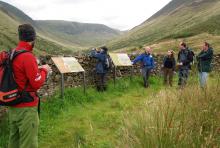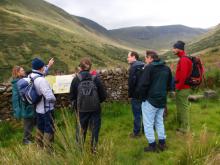
A merry coachload of conference delegates set out from Edinburgh, and travelled south and westwards through the glorious countryside of the Southern Uplands. Our destination was the Carrifran wildwood site. This isolated valley was bought on 1st January 2000 with the intention of creating deciduous woodland on moorland that was cleared of trees many centuries ago..
The Carrifran valley covers approximately 600ha of open grass and heather moorland. One of the highest mountains in the area, White Coomb is at the head of the neighbouring valley and the famous waterfall the Grey Mare’s Tail is just along the road. In 2000 the planting of trees began in the lower part of the valley. So far a mixture of half a million Birch, Hazel, Sessile Oak, Holly, Alder, Willow, Hawthorn, Rowan, Juniper, Bird Cherry, Wych Elm and Aspen has been planted on an area of 300ha by volunteers and contractors.
We were met on arrival by some of the amazing volunteers and staff who have designed, planted and managed the valley. A group of us set-off with two guides to get as far up the valley as possible, in the time available whilst a second group with two further guides proceeded at a more leisurely pace up the valley. Our aim was to see the development of the planted trees and their effects on the landscape. Although the trees are only ten years old, it is already possible to imagine how the valley might look in the future as they reach maturity. Despite the rugged terrain and wild weather establishment of the trees has been largely successful. In the more exposed areas the young trees are stunted, as you would expect.
As we climbed up alongside the burn we chatted to our guides and learned more about the history of the project and gained insights that cannot be gained in any way but through a conversation. The Carrifran story provides an example of the ‘conflicts’ that arise when groups with different conservation agendas encounter one another, and how they can be resolved through negotiation. To those of us observing conservation strategies, their success and impacts is a fascinating case study. At first glance the project aims seem quite straightforward and easy to support: the recreation of natural woodland in the uplands following the acquisition of land. You might suppose the acquisition of land would have been the most complicated part of the project. However, issues of changing landscape aesthetic and habitat proved more of a problem. The former required convincing as many locals and visitors as possible that the changes to the countryside would be both beautiful and beneficial to wildlife. In nearly all cases where a change to a familiar landscape is proposed, a proportion of the population will resist it, but many of these will change their views following publicity and dialogue. The project team carried out a rigorous publicity campaign and the number of detractors has become very few.
To ensure there were no negative impacts on the Habitat Action Plan for Scotland through changing the landscape in such a radical way, the statutory authorities had to be involved. Consequently a consultation with Scottish Natural Heritage made sure that Priority Habitat Upland Heathland will be maintained and also that the species of trees planted would conform to suitable National Vegetation Classification (NVC) woodland communities. There was quite a debate about which NVC communities would be suitable for an area which has so little remaining woodland to base suitability criteria upon and where there is uncertainty about what would have been there in the past without man’s intervention.
Planting new woodland is seen by the Scottish Government as a mitigation strategy for global warming because the growing trees sequester carbon from the atmosphere. The government, through the Forestry Commission, has a grant system for new planting that equates to a carbon credit system. The Carrifran project sensibly applied for such a grant. The grant system comes with its own rule set that applied further constraints on which species could be planted, but also when they should be planted, and what proportion must survive. The survival of young trees in the valley depends on edaphic factors, the weather and mostly on grazing pressure.
Probably the major issue for the project was to clear the area of deer and wild goats before planting started and then keep them out. The removal of animals was controversial to some locals, as the wild goats that lived there could have inhabited the area for many centuries. The valley was first fenced off, which was both expensive and difficult in the mountainous terrain. Capture and release was used to remove the goats, which meant many of the objector’s fears that the animals would be destroyed were calmed. The fencing will not prevent determined deer from entering the valley and so it is still necessary to remove animals on a regular basis. Personally I think the management of the grazing animals has been extremely successful. We saw no evidence of browsing on our visit and I think I am correct in saying that the project passed its assessment of tree survival by the Forestry Commission.
The project seems to be going from strength to strength and I hope to revisit in another 10 years to see how the woodland has grown up.

